
Centre of Jaina Studies Newsletter: SOAS - University of London
The year 2014 was celebrated as the birth centennial of the 9th head of the order of the Terapanth Jain tradition, Acharya Tulsi. In this article, I present vintage photos from Acharya Tulsi's life with a hope to give you a vivid perspective on the life of this legend. I have had the good fortune of growing up in Rajasthan where Acharya Tulsi frequently visited and spent the rainy season of 4 months, a common practice among Jain monks. This photo-journey was originally presented at the conference on the Making of Modern Jainism, organized by the Florida International University in Miami, held in October 2014. My presentation comprised a set of 90 rare pictures from Āchārya Tulsi's life, selected from a collection of more than 5,000 photos.
Acharya Tulsi was born in October 1914 in Ladnun, India, in a devout Jain trader's family. At the age of 11, Tulsi renounced his physical comforts and dedicated his life to his own spiritual journey and the wellbeing of other people. He saw the Jain path as a way to selflessly work in the service of mankind and help others find the path to their own enlightenment. He visualized how life should be lived and used his energy for the betterment of humankind, regardless of religious affiliations. He was announced as the successor of his Acharya Kalugani at the young age of 22 in the year 1936. Only 3 days after that announcement, his Acharya took his last breath, leaving him in charge of a congregation of over 500 monks and nuns and a community spread across the country.
Above everything we know about Acharya Tulsi, first and foremost, he considered himself a simple Jain monk, following the Jain monk's code of conduct every day, including meditation, yoga practice, and the daily observance of seeking forgiveness. Like any ordinary Jain monk, he took alms rounds in the community where he stayed, keeping him closely connected with the people. As you may know, Jain monks pluck the hair from their head as part of their practice rather than shaving, and he did not make any exceptions for himself (Figure 1). Acharya Tulsi was an exceptional Jain Monk, always leading by example.
In 1947, when India had just become an independent nation, Acharya Tulsi knew that the joys of freedom could lead to an unrestrained society. He wanted the religious teaching to be action-oriented, and he thought the idea of small vows as action could be a tool to affect social change. Based on that idea, in 1949, he announced the Anuvrat movement in Sardarshahr, Rajasthan. Anuvrat means 'small vows'. With this movement, he drew up a code of conduct aimed at developing character and morality by morphing traditional Jain vows for householders into small secular vows that were achievable by an individual.
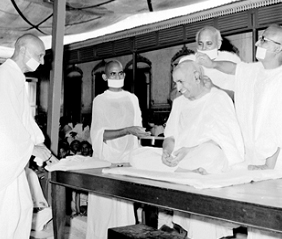
Figure 1
Dr Rajendra Prasad, the first president of India, learned about the Anuvrat movement in a meeting with Acharya Tulsi in 1950 (Figure 2). He thought he could apply this idea for the welfare of people throughout the country. Prasad extended his support to the movement and commented, 'It is like religion stepping out of its traditional boundaries to the behavioral aspect of everyday living'.
Prasad recommended that Acharya Tulsi meet Pt. Nehru, the first prime minister of India, and discuss a strategy to help move this forward. In his meeting with Acharya Tulsi, (Figure 3) Pt. Nehru was astonished when he realized that this monk was not asking him for anything, but offering him his peace force of 500 monks and nuns. Subsequently, Pt. Nehru addressed the Anuvrat Conference, and reiterated the importance of this movement to the nation, and gave his commitment and support.

Figure 2
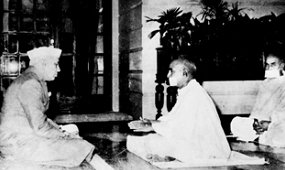
Figure 3
Acharya Tulsi set out to reach people all over India, from the remotest village to the biggest cities, without any barrier of religion, caste, gender or culture to relay the message of the Anuvrat, peace and nonviolence. In his early life, monks of his tradition travelled primarily in parts of Rajasthan. Acharya Tulsi expanded that, and he conducted extensive journeys on bare feet across rural and urban India. He was an incredibly innovative and visionary leader who was able to spread his influence despite travel constraints. A lifelong traveler, he traversed over 70,000 km in his life with only one purpose: to help human beings everywhere find their potential at an individual level. He set out to spread this message, for example, visiting the central jail in Bangalore, he reached out to the inmates and officers (Figure 4).
Acharya Tulsi's life was not without oppositions. In 1961, he wrote a poetic book titled Agni Pariksha, which translates as Trial by Fire. The book highlights the purity of Sita, a character from the Indian epic Rāmāyaṇa. After the publication, there was opposition from some people, which provoked the public, as they thought the book demeaned Sita. Also, in 1970, when he was spending the rainy season in Raipur, he received opposition that resulted in heavy violence in the city. His opponents burned down the tent (Figure 5) where he was giving his discourses, and instigated sectarian violence.
Even though Jain monks are prohibited from taking long journeys during the rainy season, he left Raipur before completing his 4-month rainy season in order to help calm the turbulent situation (Figure 6). While condemning the violence, JP Narayan, a prominent Indian social leader commented, 'After Mahatma Gandhi, this is the first example where emphasis is given to nonviolence over anything else'.
As part of their code of conduct, Jain ascetics do not use transportation and travel only on foot, so as not to cause injury to living beings. Acharya Tulsi was cognizant that the Jain teachings would have a broader impact if he added a level of initiation that was not restrictive like the traditional guidelines. To overcome this, in 1980, he established a new kind of initiates to start the Saman Order (Figure 7).
Initially, there was resistance from within his own community as well as from the broader Jain community, but Acharya Tulsi, with his vision and courage, moved forward and knew that his decision would speak for itself in due time. What started as a seed has now flourished into a large group of highly educated samanis who are taking leadership and academic roles while continuing to spread the message of peace and nonviolence throughout the world.
Acharya Tulsi wanted to make the Jain teachings accessible to all, but he realized that there was no literary work to accomplish this. He took it upon himself and a group of learned monks to translate and write commentary on the Agamas. The project was officially kicked off in 1955 in Ujjain, Madhya Pradesh. He worked, hands on, to produce translation, commentary and comparative study with other Jain works, modern science, and other religious thoughts (Figure 8). After almost 60 years of continued tireless effort by Acharya Tulsi and hundreds of monks and samanis, the original text of 32 agamas has been translated and published with commentaries. This is a monumental contribution in preserving and advancing Jain literature.
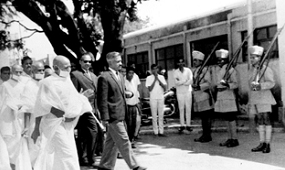
Figure 4

Figure 5
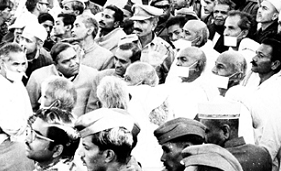
Figure 6

Figure 7
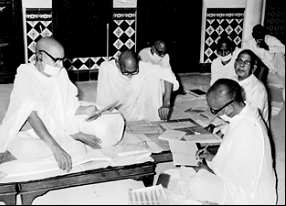
Figure 8
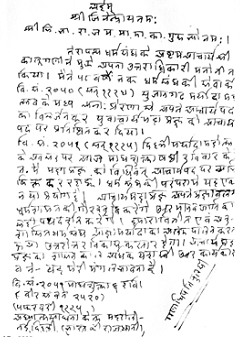
Figure 9
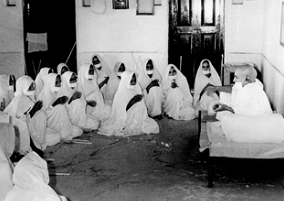
Figure 10
Acharya Tulsi had always amazed the community with bringing forth his innovative ideas. One such illustration took place in 1994 when in Sujangadh, he startled a crowd of over 10,000 by declaring that he would renounce his position as acharya (Figure 9). This was an unprecedented act, especially in a world where everyone was clamouring for getting a title. Acharya Tulsi cited two main reasons for relinquishing his position. First, he wanted to devote more time to his own spiritual practice, again highlighting that he was a Jain monk at heart, and, second, he wanted to work more for the uplifting of the human race without any of the administrative responsibilities of a position.
Right from the start, Acharya Tulsi was committed to uplifting the lower castes and women.
This was an era when gender bias was rampant in society, and there was an obvious disparity between the education of monks and nuns. Acharya Tulsi took upon himself to give nuns the equal opportunity to pursue academic goals important to their faith. Given society's structure at the time, it was a daunting task to drive this reform within his own order. He spent hours and hours of his time with them as an instructor, introducing them to scriptures, teaching them Sanskrit and Prakrit, enabling them to read and write in those languages (Figure 10). The result of this is abundantly evident. Today, we see nuns editing āgamas, writing books and commentaries, and teaching at universities around the world.
Acharya Tulsi was a prolific writer and a poet, an eloquent orator, and above all, a pious saint. In June of 1997, Acharya Tulsi's body took the last of its journeys in Ganga Shahar, Rajasthan, where his soul left his body. His last rites were concluded at this location (Figure 11), and a memorial was erected in his honour.
I would like to leave you with a poem he wrote to describe himself:
I neither want any adjectives to introduce me, nor any titles; I neither have any caste, nor I belong to any sect. My simple introduction is thus O!, here is monk Tulsi.
The author would like to acknowledge efforts of the Jain Shwetambar Terapanthi Mahasabha in collecting and digitizing these photos of Acharya Tulsi's life, and for making these available to the community.
Nirmal Baid is Founding Director of the Jain Education and Research Foundation (www.jaineducation.org). Baid received his PhD in Jainology from Jain Vishva Bharati University, India, for his dissertation: An Ontological Approach To Representing Relationships Among Jain Taxonomies.
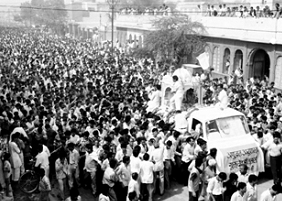
Figure 11
 Dr. Nirmal Baid
Dr. Nirmal Baid